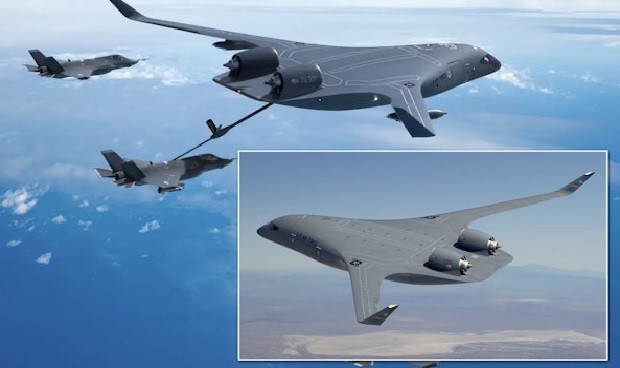Boeing Develops Blended Wing-Body Stealth Aircraft for Military In-Flight Transport and Refueling

U.S
Boeing's blended wing-body (BWB) aircraft concept merges cargo transport and refueling capabilities, promising increased fuel efficiency and stealth features for future military operations.
Boeing is paving the way for the future of military aviation with its innovative concept for a blended wing-body (BWB) aircraft. This new design combines the functions of traditional cargo planes and tankers, potentially revolutionizing modern warfare.

The BWB Advantage
The BWB design itself offers several advantages. Unlike conventional tube-and-wing aircraft, the BWB integrates the fuselage and wings seamlessly, creating a smoother, more aerodynamic shape. This translates to significant benefits:
- Increased Fuel Efficiency: The BWB's design reduces drag, leading to a potential 50% cut in fuel consumption compared to current models . This translates to greater range, loiter time, and operational flexibility.
- Enhanced Payload Capacity: The BWB's wide, airfoil-shaped body offers more space for cargo, potentially exceeding the capabilities of existing military transporters.
Stealth for the Battlefield
Boeing's concept takes the BWB design a step further by incorporating stealth features. This is crucial in an era where adversaries possess increasingly sophisticated air defense systems. The design includes elements like serpentine engine inlets, which help mask the heat signature of the engines, a major factor in radar detection.
By combining these features, Boeing's BWB concept aims to provide a vital capability for future conflicts. Here's how:
- Survivability: The stealth characteristics allow the aircraft to operate in contested airspace with a lower risk of detection. This is critical for delivering critical supplies or refueling fighter jets behind enemy lines.
- Versatility: The ability to handle both cargo and refueling operations in a single platform offers greater flexibility for commanders. This reduces the need for multiple aircraft and simplifies logistical operations.
The Road Ahead
While Boeing's BWB concept is undeniably promising, it's important to remember it's still in its early stages. The company estimates a 10-15 year timeframe before such an aircraft could enter service [2]. Challenges like developing advanced materials and integrating complex refueling systems need to be addressed.
However, Boeing's initiative reflects a growing trend in military aviation: the need for more survivable and versatile airlifters and tankers. The BWB concept offers a compelling solution, and its development will be closely watched by those invested in the future of air combat.


